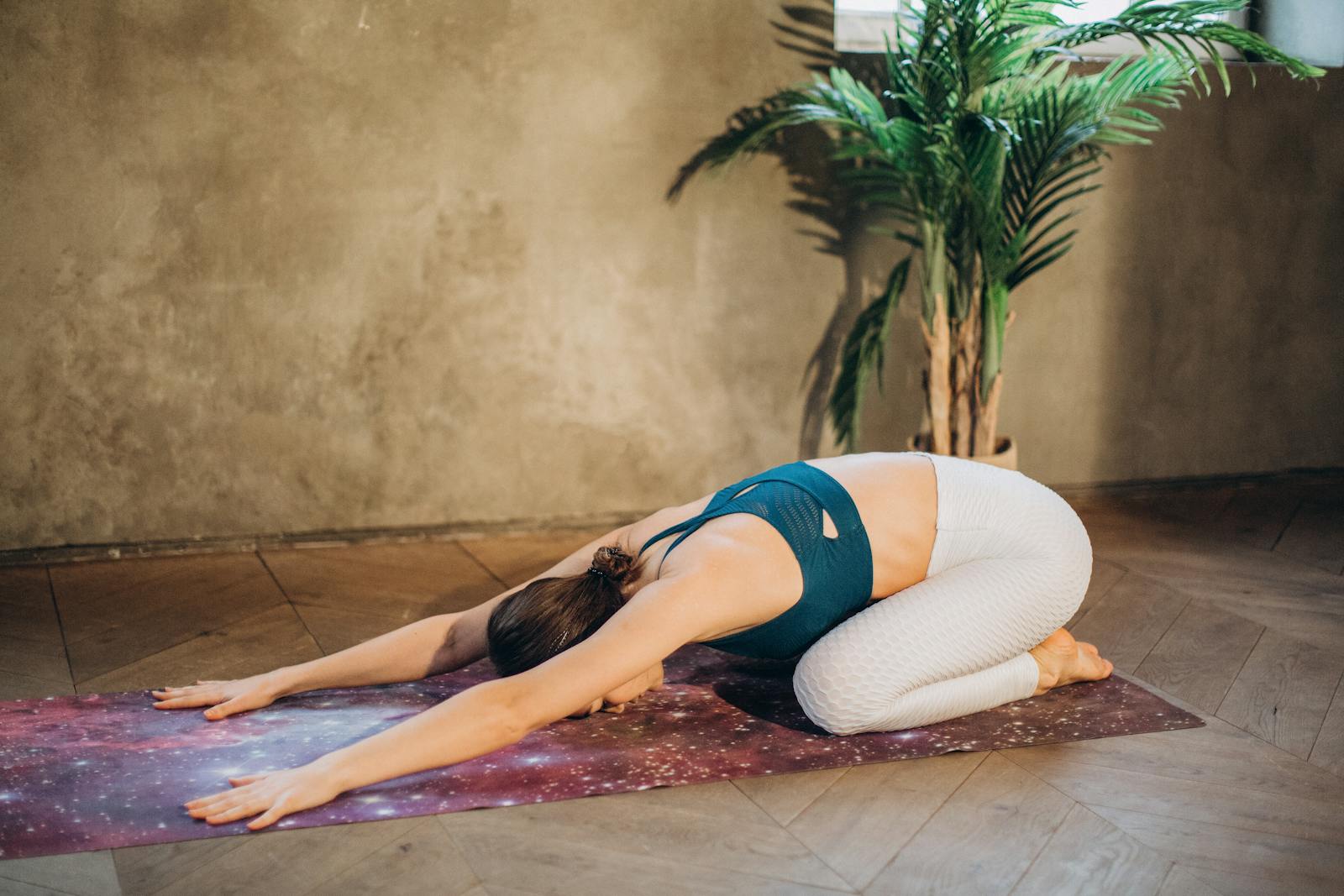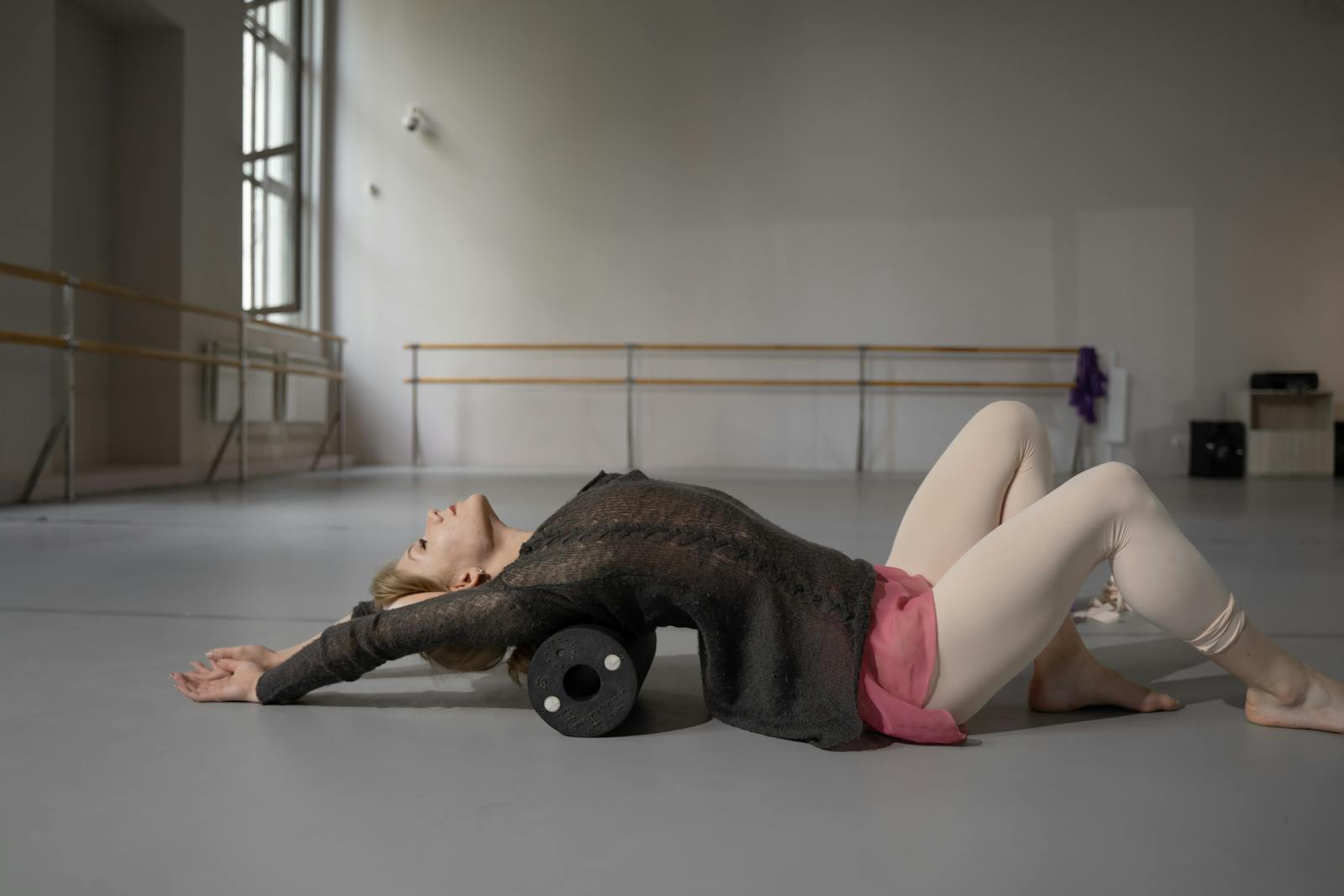The importance of mid-back stretches cannot be emphasized enough, particularly in our increasingly sedentary society. These stretches provide a multitude of health benefits, including improved posture, enhanced mobility, and a reduction in the risk of injury. While the cat-camel stretch, thoracic extension, seated twist, and child’s pose are commonly recommended, the correct techniques and precautions are crucial to guarantee their efficacy. Done correctly, these exercises can be a significant game-changer for mid-back health. This leads us to question: what are the most effective mid-back stretches, and how should they be properly executed?
Understanding Mid-Back Pain
Mid-back pain, a common ailment often associated with poor posture or muscle strain, warrants a thorough understanding to effectively address and alleviate its symptoms. This pain can be a result of various factors, which can be classified into two broad categories: pain triggers and mid-back anatomy.
Pain triggers refer to conditions or actions that instigate the discomfort. For instance, prolonged sitting or standing, poor ergonomics, lifting heavy objects, and sudden movements can all trigger mid-back pain. Additionally, underlying health issues like osteoporosis, herniated discs, and certain types of cancers can also cause this discomfort.
Understanding mid-back anatomy is pivotal in comprehending the root cause of the pain. The mid-back, medically referred to as the thoracic spine, consists of 12 vertebral bodies, intervertebral discs, facet joints, muscles, and nerves. Any disruption or damage to these structures, either through injury, age-related degeneration, or disease, can lead to mid-back pain.
Importance of Mid-Back Stretches
The importance of mid-back stretches cannot be overstated in both the prevention and management of mid-back pain. Regular and proper execution of these stretches can greatly enhance flexibility, improve posture, and reduce discomfort. In the following sections, we will explore the benefits of these stretches and the correct techniques to guarantee excellent results.
Benefits of Mid-Back Stretches
Engaging in regular stretches for the mid-back area offers a multitude of health benefits, such as improved posture, enhanced mobility, and reduced risk of injury. The stretching frequency can greatly influence these benefits: the more consistent you are with your stretching routine, the more noticeable the benefits become. Posture improvement is one of the key advantages of mid-back stretches. Regular stretching can help correct unnatural curvature and alignment issues in the spine, facilitating a more upright and balanced posture. Additionally, stretching the mid-back area helps increase flexibility and range of motion, making daily activities easier and reducing the risk of strain or injury. It also promotes better blood circulation, leading to enhanced overall well-being.
Mid-Back Stretch Techniques
To fully reap the benefits of improved posture, enhanced mobility, and reduced injury risk, it is crucial to understand and properly execute several effective mid-back stretch techniques. Stretch frequency is essential; consistent, daily routines optimize results. Utilizing stretching equipment such as resistance bands can enhance the stretch, targeting specific muscles more effectively.
Techniques like the seated twist, cat-cow pose, and child’s pose are popular for their simplicity and effectiveness. The seated twist, for instance, entails rotating your upper body while seated, which can alleviate mid-back tension. The cat-cow pose, originating from yoga, promotes spinal flexibility. Finally, the child’s pose is a restful stretch that elongates your back muscles gently. These techniques, performed with appropriate frequency and equipment, can greatly improve mid-back health.
Precautions Before Starting Stretches
Before initiating any mid back stretches, it is essential to take certain precautions to prevent injury. An assessment of your physical condition, understanding potential risks, and prior consultation with a health professional are vital. These steps guarantee a safe and effective stretching routine.
Assessing Physical Condition
It is essential to accurately assess your physical condition and any potential limitations before initiating any mid back stretches. This process begins with a thorough fitness evaluation, which measures your overall health, strength, flexibility, and endurance. It’s important to understand your body’s capabilities to make sure that the stretches you perform are both safe and effective.
A posture analysis is also an important part of the assessment. This evaluation determines the alignment and balance of the body, identifying any deviations that could potentially lead to discomfort or injury during stretching. By gaining a detailed understanding of your physical condition, you can tailor your stretching routine to your unique needs, ensuring a safer and more beneficial experience. The significance of this assessment cannot be overstated.
Recognizing Potential Risks
While starting a mid back stretching routine is generally beneficial, awareness of potential risks is important for safety and effectiveness. Risk identification plays a significant role in this process. It encompasses recognizing physical limitations, discerning between discomfort and pain, and understanding when to modify or cease certain stretches. Injury prevention is another essential aspect of ensuring safe stretching practices. It involves paying attention to proper alignment, maintaining control during movements, and allowing adequate rest between sessions. Moreover, it is essential not to push beyond your comfort level or rush the process. Remember, the goal is to enhance flexibility and alleviate tension, not to cause further harm to your mid back. Hence, careful consideration of these potential risks is key to a successful and safe stretching routine.
Prior Consultation Importance
Understanding the importance of prior consultation, particularly with a health professional, is a vital precaution before initiating any mid-back stretching routine. The consultation benefits are numerous; it provides an opportunity to discuss your health history, existing conditions, and potential risks involved.
Doctor’s advice is essential as they can recommend suitable and safe stretches based on your unique health profile. They can caution against certain movements that may exacerbate existing issues or lead to injury. Additionally, consultations empower individuals with the knowledge of how to perform stretches correctly, maximizing benefits, and minimizing risks.
Cat-Camel Stretch Technique
The Cat-Camel Stretch Technique, a popular option among physiotherapists, offers significant relief from mid-back discomfort by promoting flexibility and strength. It is a simple but effective exercise designed to mobilize the spine and strengthen the core and back muscles. The stretch timing and intensity play pivotal roles in determining the effectiveness of this stretching technique.
Stretch timing is important in the Cat-Camel stretch as it involves a sequence of movements that need to be performed in a slow and controlled manner. A typical cycle should take about 5-10 seconds, alternating between the cat (arched back) and camel (rounded back) positions. The gradual sequence allows for a deeper stretch and better control over the movement.
The stretch intensity, on the other hand, should be moderate. The goal is to feel a gentle stretch in the spine without causing any discomfort or pain. Overstretching can lead to strain or injury, so it’s important to listen to your body and adjust your intensity accordingly.
To conclude, the Cat-Camel Stretch Technique is a valuable tool in maintaining spinal health and alleviating mid-back discomfort. Proper stretch timing and intensity are key to maximizing its benefits.
Thoracic Extension Stretch Guide
Another essential mid-back exercise is the Thoracic Extension Stretch, which specifically targets the thoracic region of your spine to enhance flexibility and reduce discomfort. This stretch is highly recommended for individuals who spend a significant amount of time in a seated position, such as office workers or drivers, as it alleviates the stiffness caused by prolonged periods of immobility.
The Thoracic Extension Stretch can be performed with or without equipment, depending on one’s comfort level and availability of resources. If you choose to use equipment, a foam roller or a firm rolled-up towel can suffice. Position the foam roller or towel across the mid-back, below the shoulder blades, while you lay on the ground. Gently extend your back over the roller or towel, creating a gentle stretch in your thoracic spine.
When considering stretching frequency, it’s crucial to remember that consistency is key for sustained relief and improved flexibility. It’s advisable to perform the Thoracic Extension Stretch daily, ideally after periods of prolonged sitting or before engaging in strenuous physical activities. However, everyone’s body responds differently to stretching, so it’s important to listen to your body and adjust your stretching frequency accordingly.
Seated Twist Stretch Instructions
While exploring for extended periods can often lead to stiffness in the mid-back, incorporating the Seated Twist Stretch into your daily routine can alleviate discomfort and improve flexibility. This stretch, when done correctly, comes with numerous twist benefits. It not only aids in relieving tension but also promotes a better sitting posture, enhancing overall spinal health.
Let’s now investigate the step-by-step instructions to perform the Seated Twist Stretch:
- Starting Position: Begin by sitting up straight on a chair, feet flat on the floor. Make sure that your sitting posture is correct with your shoulders relaxed.
- Twist Movement: Slowly turn your upper body to one side, keeping your hips stationary. Use the chair for support, holding onto the back or armrest. Hold this position for about 20 to 30 seconds.
- Switch Sides: Return to the starting position and repeat the twist movement on the opposite side.
Child’s Pose Stretch Description
The Child’s Pose, also known as Balasana, is a simple yet highly effective mid-back stretch. This section will provide a detailed description of how to correctly perform this pose, ensuring maximum benefit and safety. Additionally, we will explore the numerous benefits associated with regular practice of the Child’s Pose, focusing on its impact on mid-back flexibility and strength.
Performing the Child’s Pose
Originating from yoga, Child’s Pose offers an effective stretch for the mid-back, promoting flexibility and relief from tension. This pose is not only beneficial for the back but also introduces breathing techniques that are an integral part of yoga benefits.
To perform the Child’s Pose, follow these steps:
- Start on your hands and knees. Sit back on your heels, keeping your toes together and knees hip-width apart.
- Lower your torso between your knees and extend your arms in front of you, palms facing down.
- Relax and breathe deeply, allowing the stretch to sink into your mid-back.
Benefits of Child’s Pose
Incorporating Child’s Pose into your stretching routine can offer numerous health benefits, particularly for the mid-back region. This pose targets the muscles between your shoulder blades, promoting flexibility and reducing tension. Regular practice can help improve posture, alleviate back pain, and enhance mobility – key yoga benefits that extend beyond physical wellness.
Moreover, Child’s Pose is not just about attaining physical fitness. It is equally beneficial for mental relaxation. As a restorative pose, it allows you to focus inward, promoting a sense of calm and reducing stress levels. It creates a connection between your body and mind, helping to improve mental clarity and focus. Therefore, the Child’s Pose is a holistic stretch, offering a blend of physical relief and mental tranquility.
Latissimus Dorsi Stretch Details
Understanding the mechanics of the Latissimus Dorsi stretch requires a detailed exploration into the anatomy and function of this large, fan-shaped muscle located in the back. Also known as the lats, the Latissimus Dorsi muscle plays a pivotal role in numerous upper body movements. Its primary function is to assist in the extension, adduction, horizontal abduction, flexion from an extended position, and internal rotation of the shoulder joint. Consequently, the Dorsi muscle functions are integral to many activities, from swimming to climbing.
The benefits of a regular Lats workout are twofold. To begin with, it enhances upper body strength, thereby improving performance in various sports and daily activities. Additionally, it promotes better posture and reduces the risk of back injuries.
To gain the full benefits of the Latissimus Dorsi stretch, keep in mind the following:
- Always warm up before stretching to prepare the muscles and prevent injury.
- Maintain a slow, controlled movement throughout the stretch to maximize its effectiveness.
- Avoid overstretching; a gentle pull should be felt in the muscle, not pain.
Doorway Stretch Procedure
How does one correctly perform the Doorway Stretch, a popular exercise targeting the mid-back muscles? To begin, position yourself in an open doorway. Spread your arms out to the sides and place your palms on the door frame at about shoulder height. Your elbows should be slightly below your shoulders.
Next, position one foot in front of the other, with your front knee slightly bent. Lean forward into the doorway until you feel a stretch in your chest and mid-back. The stretch intensity can be adjusted by altering how far you lean into the doorway. The more you lean, the more intense the stretch will be. It’s important to keep your back straight and your head up during this exercise to maintain proper form and prevent injury.
In terms of stretch frequency, it’s recommended to perform this exercise two to three times a day, holding each stretch for 15-30 seconds. Remember to breathe deeply and relax as you hold the stretch. With regular practice, the Doorway Stretch can help alleviate tension and stiffness in your mid-back, promoting better posture and reducing the risk of back-related issues.
Sustaining a Regular Stretch Routine
Maintaining consistency in performing your stretch routine, such as the Doorway Stretch, is key to reaping the long-term benefits and achieving a healthier, more flexible back. Establishing a regular stretching routine requires discipline, but when performed correctly and consistently, it can greatly improve your overall health and mobility.
The stretching frequency should ideally be daily. If that’s not possible, aim to stretch at least three times a week. Regular stretching will not only enhance your back flexibility but also promote better posture and reduce the risk of back pain.
When it comes to stretching equipment, there are several options available. The choice of equipment will depend on your comfort level, the specific stretch, and its purpose. Here are three common tools:
- Stretching Strap: This versatile tool can help deepen your stretches and improve your range of motion.
- Stability Ball: It’s excellent for performing a variety of stretches and strengthening exercises.
- Foam Roller: This can be used to ease muscle tightness and improve flexibility.
When to Consult a Professional
While a regular stretching routine can greatly enhance your back health, there are instances when professional advice or intervention becomes essential to address persistent or severe symptoms. For instance, when back pain persists despite regular stretching and rest, or when the pain impairs your mobility or quality of life, it is vital to seek professional guidance. An expert can help identify the underlying causes of your discomfort and provide appropriate therapy options.
Chronic mid-back pain might indicate more serious conditions such as herniated discs, arthritis, or spinal stenosis. If you experience symptoms like numbness, tingling, or weakness in your arms or legs, or if your pain is accompanied by unexplained weight loss, fever, or bowel or bladder problems, immediate professional consultation is necessary.
Professionals like physiotherapists, chiropractors, and orthopedic specialists can offer a range of therapy options including manual therapy, acupuncture, and targeted exercise programs. They can also provide guidance on maintaining a proper posture and designing a safe, effective stretching routine tailored to your needs. Don’t overlook the importance of professional input in ensuring your back health.
Frequently Asked Questions
How Long Should I Hold Each Mid-Back Stretch Position?
For ideal stretching benefits, each stretch position should be held for approximately 30 seconds. This duration, combined with regular stretching frequency, promotes flexibility, reduces tension, and enhances overall muscle health and performance.
Can Mid-Back Stretches Help With Posture Correction?
Yes, stretching benefits include aiding in posture correction. Regular mid-back stretches can enhance flexibility and strength, contributing to improved posture. A posture analysis may help identify specific stretches beneficial for individual posture needs.
Are There Specific Stretches for Older Adults Suffering From Mid-Back Pain?
Yes, older adults can utilize stretching equipment for targeted mid-back pain relief. Gentle exercises like seated twists, cat-camel stretch, or thoracic extension can be beneficial. Always consult a healthcare professional before starting any exercise regime.
What Are Some Signs of Overstretching or Injury During Mid-Back Stretches?
Signs of overstretching or injury during stretching exercises may include severe discomfort, sharp or lasting pain, limited mobility, swelling, and bruising. Recognizing these Stretching Risks is essential for effective Injury Prevention.
Can I Incorporate These Stretches Into a Yoga or Pilates Routine?
Yes, incorporating these stretches into your yoga or pilates routine can be beneficial. Consider the stretching frequency and the specific stretching benefits that align with your fitness goals for an effective and safe regimen.



